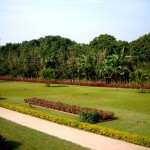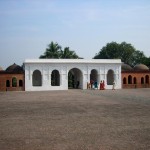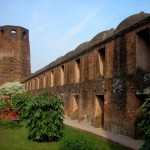Being a resident of Kolkata, West Bengal, I have always preferred Murshidabad as a convenient weekend getaway. Quite contrary to my friends who unfailingly sneaked in to the over explored seas of Digha, I made it a point to make short trips to Murshidabad on short holidays. Here, I would like to speak about my experience of witnessing one of its famous buildings- the Katra Mosque. It is located around 3 km east of the historical city (i.e. Murshidabad) and around 200 kms from Kolkata.
The Mursidabad rail station is nearby as well (Katra Mosque situated at 1.5 kms–north-eastern part of the station). Built between the year 1723 and 1724 by Nawab Murshid Quli Khan, this building served as an important centre of Islamic learning.
History of Katra Mosque
The mosque derives its name “Katra” from the bustling market place that surrounded it. Katra means marketplace. It is place where Nawab Murshid Quli Khan had been buried. The earthquake of 1897 had considerably destroyed this mosque, believed to be the replica of Kartalab Khan’s mosque in Dhaka (built in around the year 1700-1704 AD).
- Katra Masjid Garden, Murshidabad
- Katra Masjid can accommodated around 2000 Namaz readers
- Katra Mosque, Inside
Structure
The Archaeological Survey of India has made sure that the remains of this important structure are well cared for. The main gate would lead you to a massive courtyard that is believed to have accommodated around 2000 Namaz readers at the same time! There are huge domes and two minarets standing at 70 feet. The other two minarets are believed to have been destroyed by the quake. Each of the domes had these semi-circular patterns (Mihrabs) in the wall that point towards the Kabba in Mecca. (Climbing a good 67 steps (22 meters) up you will find 2 of the surviving pillars from which you can take a considerable view of the surroundings. each on the terrace. There are two pillars with 15 meter radius. The other pillars, here, have been destroyed).
The mosque is replete with intricate designs and stretches across a whopping 40*71/2 metres. You can only wonder at the overwhelming grandeur of this structure. The huge door embracing the entrance has some Iranian words written on it. The writing extols the Muhammad of Arab. Sarfaraj Khan’s Futi Masjid is placed at the west of the Katara Mosque at the edge of the railway line. This one replicates the Katara Mosque. The Topkhana is a castle, situated at the south eastern side of Katara.
Interesting Facts about Katra Mosque in Murshidabad
It is claimed that an individual named Farash Khan was assigned the task of building this mosque. He, apparently, was not very fond of Hindus and had built the masjid using materials collected after destroying Hindu temples. This one served as the residence of 700 Quran readers. There are no wooden panels on the ceilings here.
How to Reach the Katra Mosque
- Murshidabad Railway Station Junction is the nearest railway station near the Katra Masjid. They are set just a kilometer apart.
- The Jiaganj railway Station is around 6.7 km away
- The Beldanga Railway Station is around 28.3 km
- Train would be a safer and more convenient means of travel here, as the nearest airport (i.e. Rajshahi Airport) is 34 km away!
In fact reaching Murshidabad from Kolkata or Howrah is very easy as a lot of trains are available.
When Should You Visit this Place?
It is ideal to avoid the scorching summers while you’re heading for Murshidabad. Target the time between October to February. The temperature hovers around the 20s (hardly rising above it) thus providing you the much needed respite from the humid summers. The mosque is open for visitors on all days between 5-6 pm.
Accommodation
There is no dearth of cheap hotels around the Masjid. The fact that there is a wide array of 3, 4 and 5 star hotels present in and around the mosque, substantiates the claim that it is one of the most oft-visited places in Murshidabad.
The nearest place to stay, however, would be WBTDC’s Raiganj Tourist Lodge. The price would vary around INR 500- INR 1000 per night.
Image Source: Tarun Pradhan



